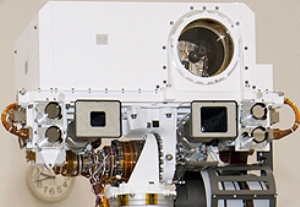On August 6, 2012, NASA’s Mars Science Laboratory completed a 350-million mile journey on the Martian surface with the help of its large Curiosity rover.
 Head of Curiosity's remote sensing mast shows seven of the 17 cameras on the rover (photo courtesy of NASA/JPL-Caltech/MSSS)
Head of Curiosity's remote sensing mast shows seven of the 17 cameras on the rover (photo courtesy of NASA/JPL-Caltech/MSSS)
Curiosity has 17 cameras and devices, which were developed by NASA’s researchers, engineers and contractors using Zemax optical and illumination design software. NASA and its worldwide network of contractors extensively utilize Zemax.
Zemax was utilized to assist designing optics for the following instruments on Curiosity:
- Two MastCam cameras offer numerous spectra and true-color imaging.
- Eight HazCam black-and-white cameras are placed on the lower part of the front and rear of the rover. These systems utilize visible light to take three-dimensional (3D) images and to protect the rover from getting lost.
- Four NavCam black-and-white cameras are placed on the mast. These cameras utilize visible light to capture panoramic 3D images.
- One ChemCam spectrometer uses a laser-induced breakdown spectroscopy for the vaporization and analysis of a trace amount of soil or rock.
- The Mars Hand Lens Imager camera is placed on a robotic arm of the rover. It is utilized to capture microscopic images of soil and rock.
- The MSL Mars Descent Imager captures the descent to the extraterrestrial surface and is used to map the surrounding terrain.
Zemax is utilized to design optical systems on several NASA spacecraft, which include two earlier Mars rovers, namely Opportunity and Spirit. Opportunity’s Mars landing was in 2004 and it continues to operate and record spectacular imaging.
Radiant Zemax’s Chief Technology Officer, Ken Moore informed that Zemax is the preferred tool for engineers taking part in challenging optics and illumination projects. Zemax is suitable to design, model and upgrade optical systems for the challenges of planetary exploration.